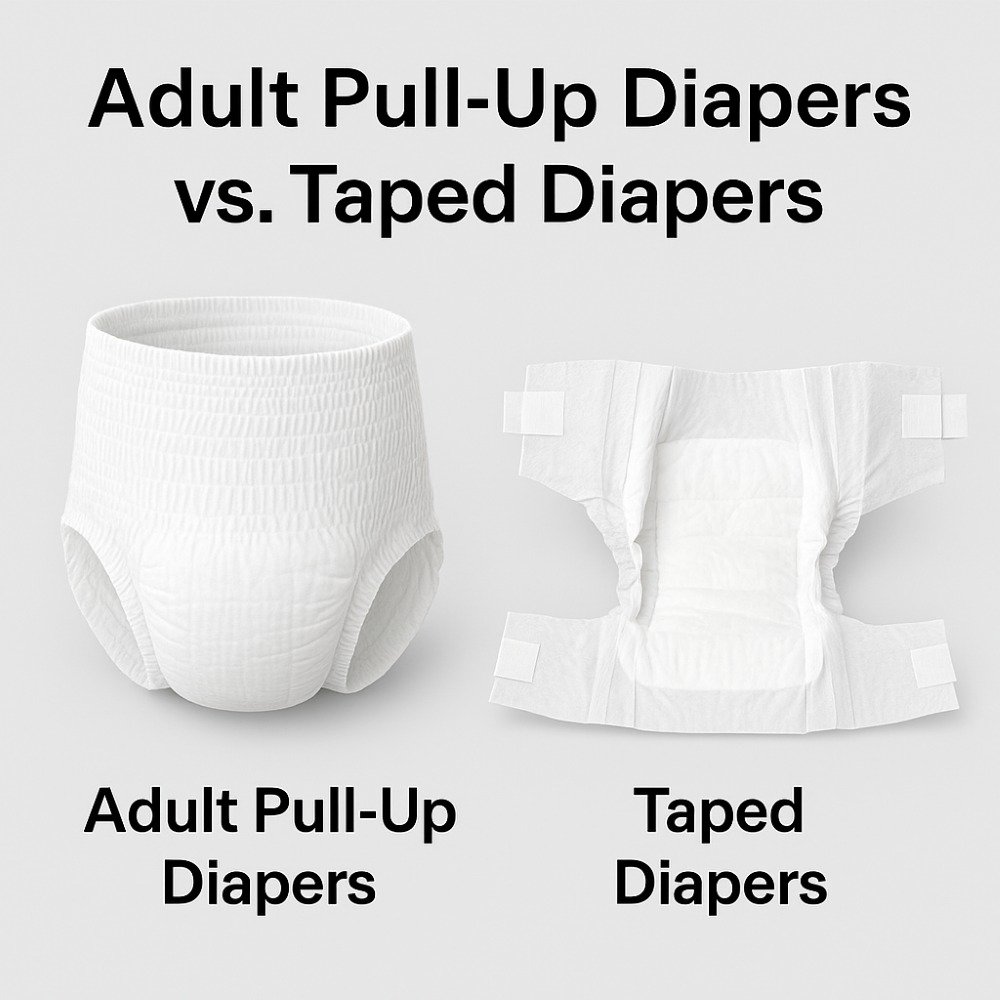In today’s global incontinence care market—growing at an estimated USD 20.7 billion in 2024 and projected to reach USD 37 billion by 2033—manufacturers and brand partners are racing to meet diverse consumer needs. Adult pull‑up diapers (“pants”) and taped (tab-style) diapers are the two dominant formats. Each format appeals to distinct segments, and choosing the right offering is crucial for brands, wholesalers, distributors, and supply‑chain managers aiming for market share and long-term growth.
This article explores the differences, use cases, production considerations, and product strategy to help you decide which format to include—or if both—to maximize product line success.
Inhaltsübersicht
1. Understanding the Formats 🎯
1.1 Pull‑Up Diapers (Pant-Style)
Pull-up diapers resemble underwear—soft, elastic waistbands and clothlike sides offer discreet comfort. They’re designed for independence, fast changes, and convenience.
Advantages:
User autonomy: Can be pulled on/off like underwear—ideal for active or semi-ambulatory adults.
Discreet & dignified: Clothlike outer layers mimic everyday undergarments.
Elastic comfort: Stretchy waist and leg cuffs adapt to movement.
Trade-offs:
Changing requires complete removal.
Less practical for completely immobile individuals.
1.2 Taped (Tab‑Style) Diapers
Featuring adjustable side tapes—often with PP tape or Velcro tape—these are caregiver-friendly, ideal for bedridden or limited-mobility users.
Advantages:
Easy application: Open and fasten while user remains seated or lying down.
Hohe Absorptionsfähigkeit: Larger core capacity—beneficial for heavy incontinence.
Sicherer Sitz: Adjustable tabs accommodate varying body shapes.
Trade-offs:
Bulkier appearance may feel institutional.
Less discreet wearing under clothing.

2. Target Users & Market Segments
2.1 Pull‑Up Diapers
Target demographics: active seniors, those with mild-moderate incontinence, rehabilitation patients, and users transitioning from taped models.
Primary sales channels: retail outlets, e-commerce, pharmacy chains.
2.2 Taped Diapers
Ideal for home-care, senior living, and long-term care facilities.
Preferred by caregivers managing bedridden individuals due to ease-of-use and high absorbency.
3. Production & Customization: OEM and Private‑Label Capabilities
OEM and private-label manufacturing offer diaper brands full control over product specifications, branding, and packaging.
3.1 Customization Options
Sizes: Typically range from M to XXL for both styles.
Absorptionsfähigkeit: Available in standard, heavy-duty, or overnight variants.
Materialien: Nonwoven breathable topsheets, high-absorbency cores, clothlike backsheets, and elastic leg cuffs.
Branding: Customizable tapes, outer materials, and packaging design.
3.2 Supply Chain Support
Reliable manufacturers offer:
Stable raw material sourcing
ISO-certified production
Flexible minimum order quantities (MOQs)
Support for global logistics, including FOB and CIF terms
A capable OEM partner helps you tailor products to your market’s needs while managing costs, quality, and lead time.
4. Choosing the Right Fit for Your Product Strategy
When expanding your adult incontinence product line, understanding how each format supports user needs and usage environments is key. Pull-up diapers and taped diapers don’t compete—they complement.
Brands that serve diverse demographics will often benefit from offering both. Pull-up styles cater to individuals who prefer self-care and discretion, while taped briefs are often preferred by caregivers and medical facilities for their ease of application and superior containment for heavier incontinence.
If your business is focused on consumer retail or pharmacy channels, pull-ups may be your leading product. But if you’re supplying to long-term care facilities, hospitals, or home-care providers, taped styles could become the foundation of your incontinence line.
Many successful brands begin with one format and expand based on customer demand and logistical compatibility. The key is to align product choices with your target segment’s daily routines, support structure, and lifestyle priorities.

5. Comparison Table: Pull-Up vs. Taped Diapers
| Criteria | Pull‑Up Pant | Taped (Tab‑Style) |
|---|---|---|
| User mobility | Good for active or semi-ambulatory individuals | Best for immobile or care-dependent users |
| Changing process | Full removal required | Re-fastenable; suits caregivers |
| Absorbency options | Designed for moderate incontinence | Customizable for heavy and overnight use |
| Discreetness under clothing | More discreet, similar to regular underwear | Slightly bulkier; less fashion-conscious appeal |
| Caregiving convenience | Moderate — suitable for self-care | High — tape readjustment helps caregivers |
| Market target | Retail, e‑commerce, pharmacy | Senior living, healthcare, home-care supplies |
6. Customer Use Cases & Real-World Scenarios
Understanding the day-to-day experience of end users helps define your ideal product mix.
A mobile, independent senior living alone may prefer pull-ups for ease and dignity.
A bedridden patient in a care facility would benefit from taped diapers with high absorbency and caregiver support.
A caregiver managing an elderly parent at home may use both formats—pull-ups for daytime, taped briefs at night.
Your product line can reflect these real-life routines by offering flexible choices that support health, dignity, and convenience.
7. Building a Strong Product Offering for the Market
Rather than focusing on search visibility, let’s talk about market needs and how to meet them through smart product development.
A well-rounded adult incontinence product offering doesn’t just rely on quantity or variety—it’s built on matching the right product format to the right situation. Pull-up pants should deliver on comfort, ease of use, and mobility. Taped diapers should offer reliable absorption, adjustability, and ease for caregivers.
Whether you’re developing products for a retail shelf, home care distribution, or clinical settings, clarity in your assortment matters. Consider separating your product line not just by format (pull-up vs taped) but also by:
Absorbency levels (daytime vs overnight)
User mobility (active vs bedridden)
Care environment (self-managed vs assisted care)
When you make these distinctions clear in your offering, it’s easier for your customers—whether B2B clients or professional buyers—to choose the right solution with confidence.
8. Strategic Recommendation for Product Development Teams
Pull-up and taped adult diapers each meet different needs, and your final decision should rest on the profile of your core market and how your product will be used.
If your target customers are independent users or caregivers purchasing for active seniors, pull-up diapers may be the ideal starting point.
If your focus is more on nursing care institutions or hospitals, where quick changes and high absorbency are priorities, taped diapers are essential.
For companies aiming to build a full-service adult care product line, offering both formats provides flexibility and positions your brand as a complete solution provider.
Ultimately, what matters most is user dignity, product reliability, and ease of use. Your product line should reflect these values across all formats. When done right, your diapers become more than just products—they become a trusted part of your customer’s daily care routine.

9. Call to Action
Looking to expand your adult incontinence product line with premium quality and flexible private label options?
New EcoCare offers:
OEM adult pull‑up production and custom tab‑style adult briefs
Bulk incontinence product supply with low MOQ
White label adult diaper manufacturing tailored to your brand
Reliable global logistics, warehousing, and support
👉 Contact us today to request a quote or sample kit, and explore how we can help you grow your adult care brand with confidence.

